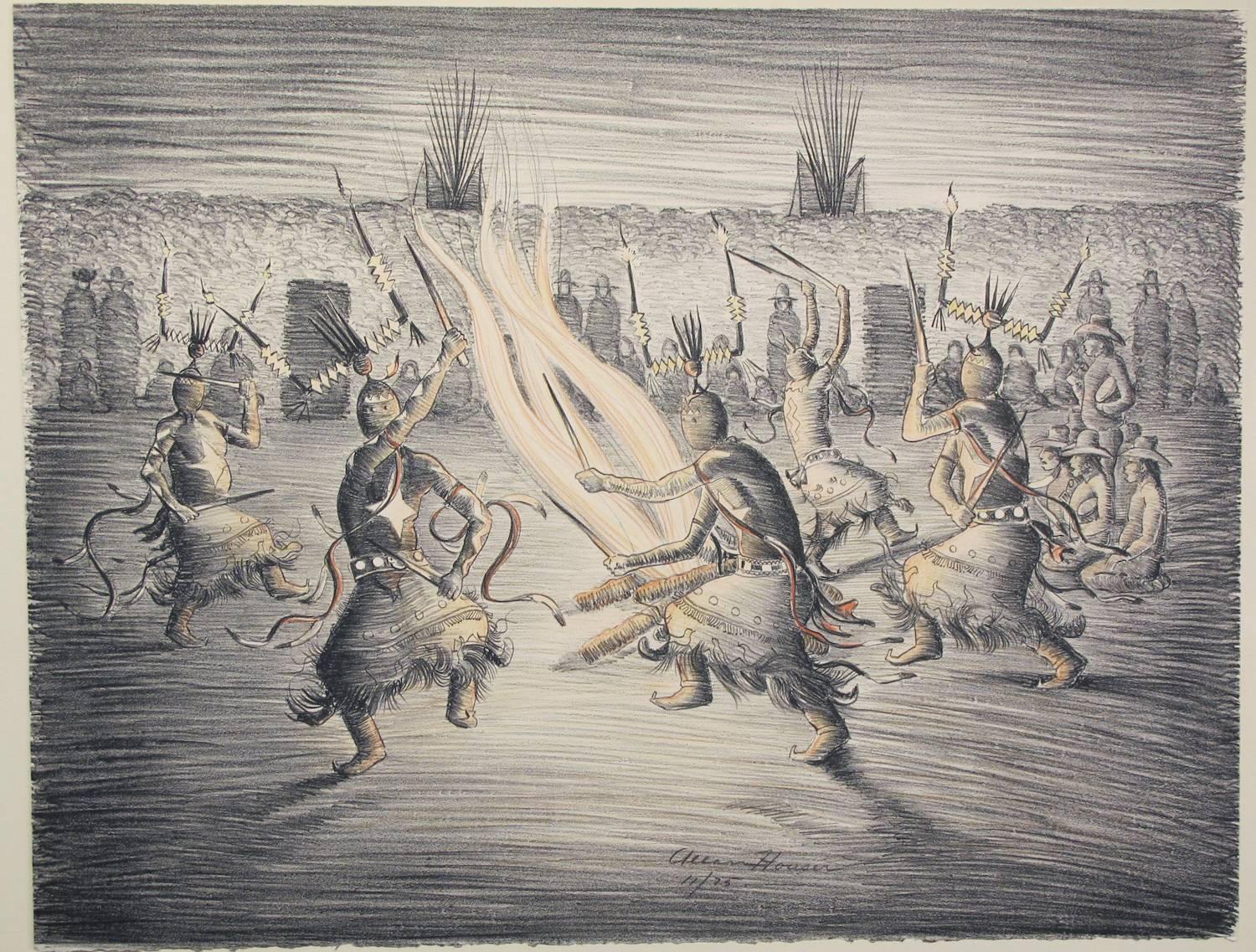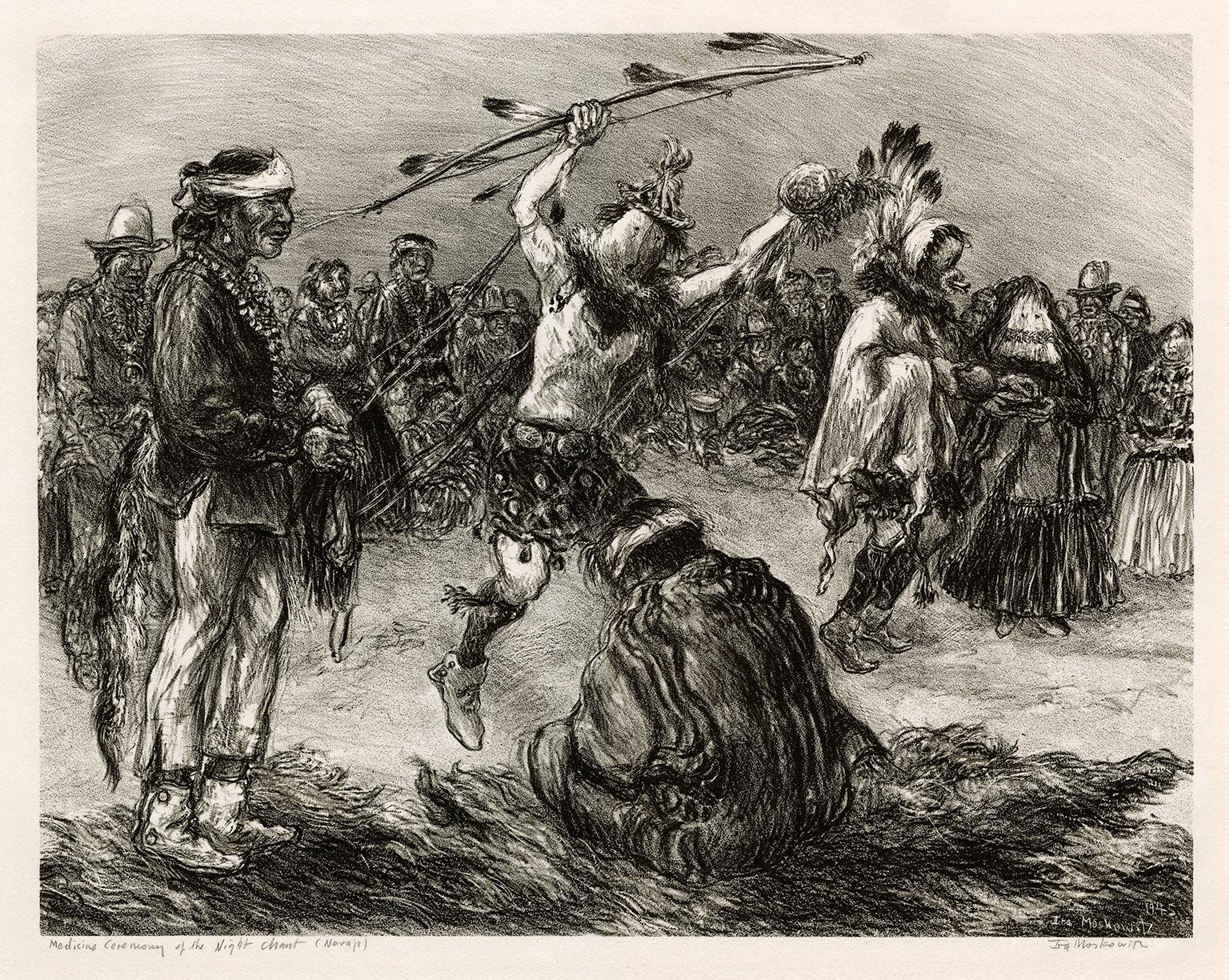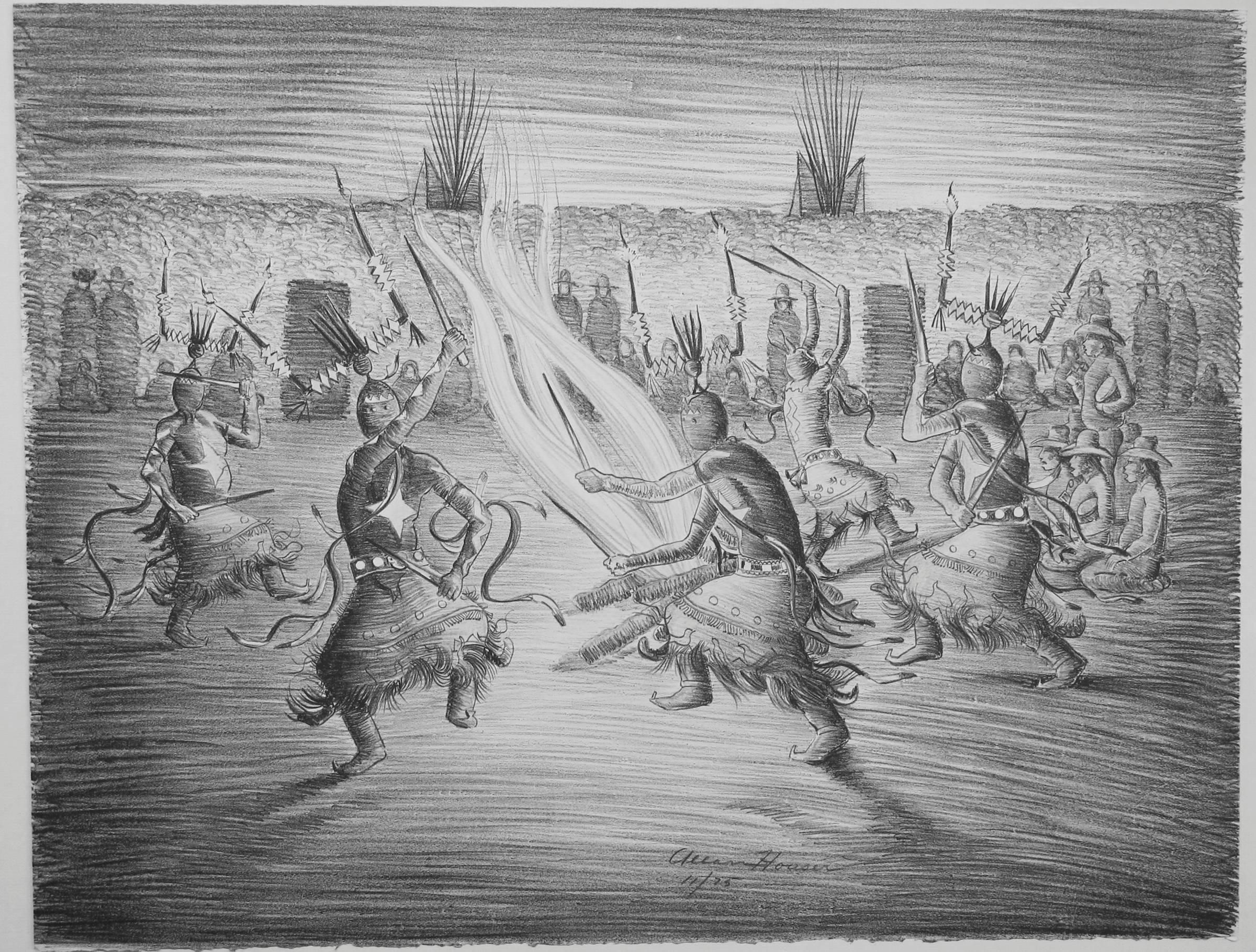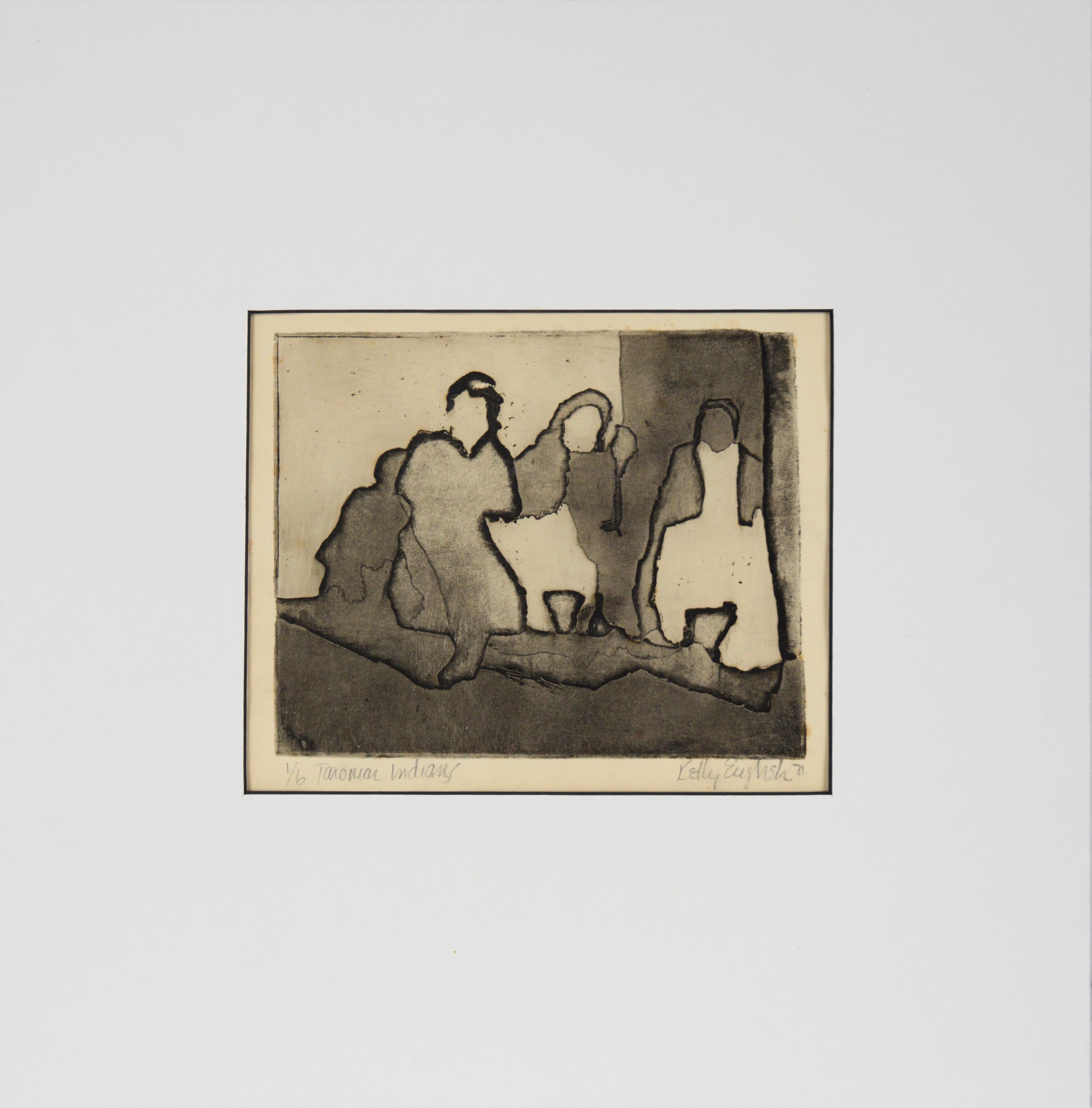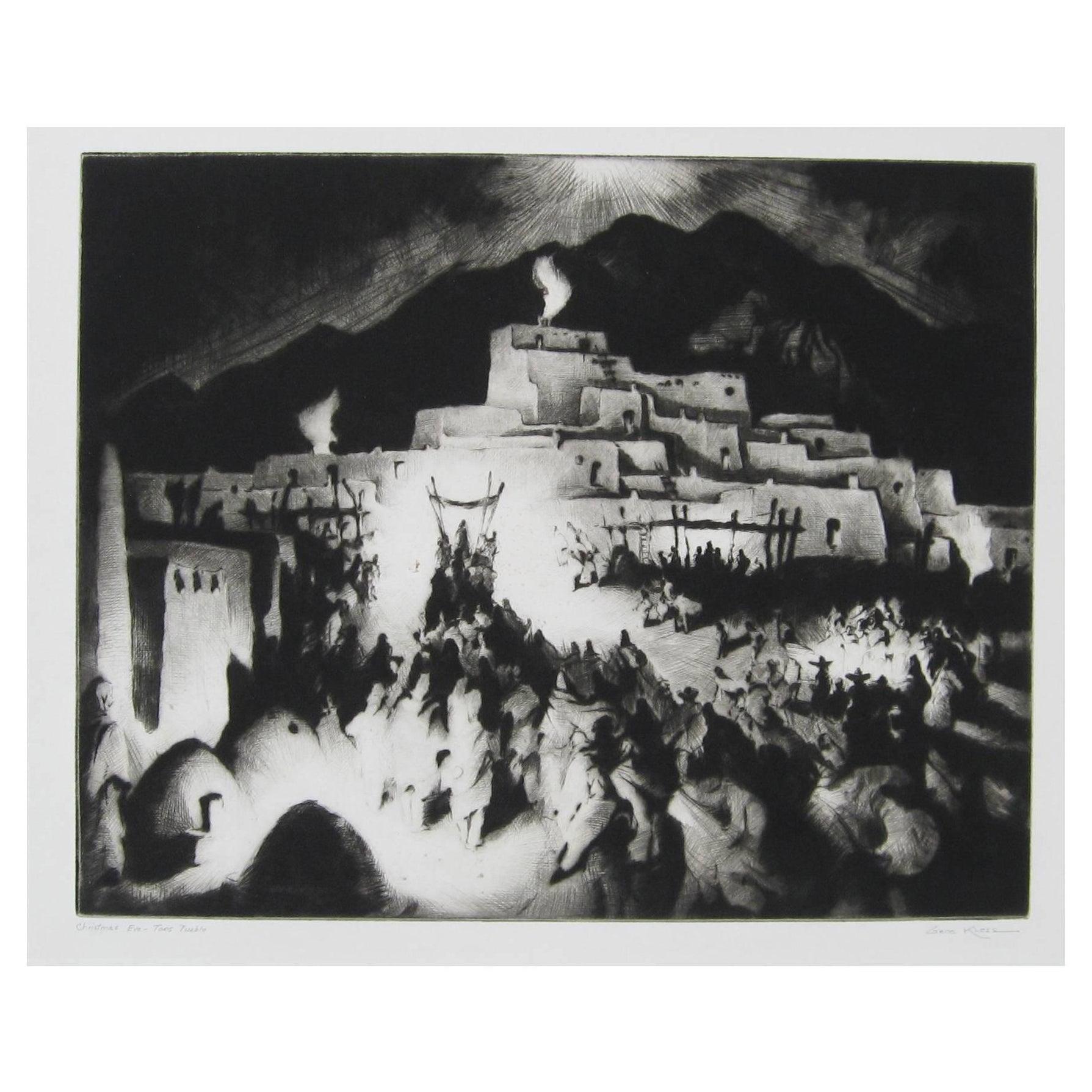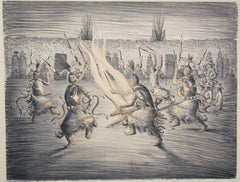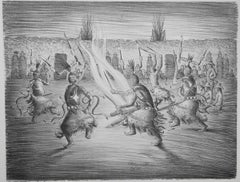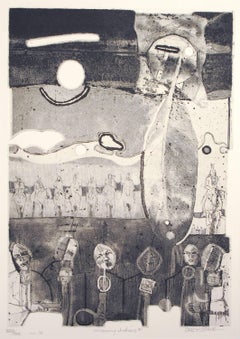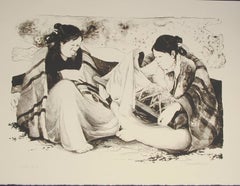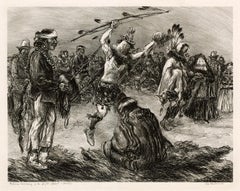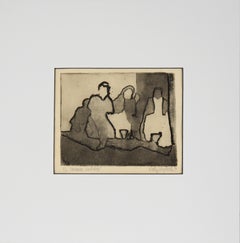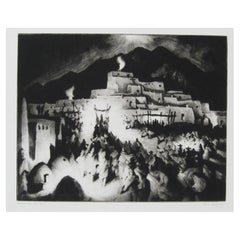Items Similar to Yei Bi Chei, etching, Navajo ceremony, black, white
Want more images or videos?
Request additional images or videos from the seller
1 of 8
Grey CohoeYei Bi Chei, etching, Navajo ceremony, black, white
$2,200
£1,718.37
€1,947.98
CA$3,153.95
A$3,459.71
CHF 1,810.17
MX$41,177.40
NOK 22,863.58
SEK 21,446.45
DKK 14,548.62
About the Item
black and white etching on paper
unframed
#14/30
image size 12 x 14.5
signed, titled & numbered by the artist under the image on the front.
COHOE, Grey 1944-1991
PERSONAL: Born 1944, in Tocito, NM; died November 2, 1991. Education: Attended Institute of American Indian Arts, 1966-67, College of Santa Fe, 1967, Fort Lewis College, 1968, and Haystack Mountain School of Crafts, 1967; University of Arizona, B.F.A., 1971, M.F.A., 1974.
CAREER: Painter, poet, and fiction writer. Art instructor for Navajo Indian tribe, Tocito, NM, 1965; Institute of American Indian Arts, Santa Fe, NM, instructor, 1975-early 1980s; Haystack Mountain School of Crafts, workshop instructor, 1976. Presenter of poetry readings and lectures. Exhibitions: Paintings exhibited in solo and groups shows, including Smithsonian Institution, Tucson Olympic Pavilion, Mexico City, Navajo Community College, touring exhibitions of U.S. Information Agency, U.S. Department of State, and International Communications Agency, and Native American Center for the Living Arts; work collected at Arizona State Museum, Institute of American Indian Arts Museum, and Philbrook Museum of Art.
AWARDS, HONORS: Art awards from Arizona State University, Heard Museum Guild Indian Fair and Market, and Scottsdale National Indian Arts Exhibition.
WRITINGS:
(Illustrator) Claude Aubry, The King of the Thousand Islands (fairy tales), translated from the French by Harvey Swados, Doubleday (Garden City, NY), 1971.
Work represented in anthologies, including Design for Good Reading, [New York, NY], 1969; The Whispering Wind, edited by Terry Allen, Doubleday (New York, NY), 1972; Myths and Motifs in Literature, Free Press (New York, NY), 1973; and Ethnic American Short Stories, Simon & Schuster (New York, NY), 1975. Contributor of poetry, prose, and fiction to periodicals, including Nimrod, Pembroke, and South Dakota Review.
- Creator:Grey Cohoe (1944 - 1991, Native American)
- Dimensions:Height: 12 in (30.48 cm)Width: 14.5 in (36.83 cm)
- Medium:
- Movement & Style:
- Period:
- Condition:
- Gallery Location:Santa Fe, NM
- Reference Number:1stDibs: LU19121894493
About the Seller
4.9
Vetted Professional Seller
Every seller passes strict standards for authenticity and reliability
Established in 1966
1stDibs seller since 2015
103 sales on 1stDibs
Typical response time: <1 hour
- ShippingRetrieving quote...Shipping from: Santa Fe, NM
- Return Policy
More From This Seller
View AllApache Mountain Spirit Dancers, lithograph, Apache, Allan Houser Haozous black
By Allan Houser
Located in Santa Fe, NM
Apache Mountain Spirit Dancers, lithograph, Apache, Allan Houser Haozous black
Hand colored original lithograph edition by Allan Houser
hand printed in Santa Fe, New Mexico
Allan Houser (Haozous), Chiricahua Apache (1914-1994)
Selected Collections
Centre Georges Pompidou, Paris, France * “They’re Coming”, bronze
Dahlem Museum, Berlin, Germany
Japanese Royal Collection, Tokyo, Japan “The Eagle”, black marble commissioned by President William J. Clinton
United States Mission to the United Nations, New York City, NY *"Offering of the Sacred Pipe”, monumental bronze by Allan Houser © 1979 Presented to the United States Mission to the United Nations as a symbol of World Peace honoring the native people of all tribes in these United States of America on February 27, 1985 by the families of Allan and Anna Marie Houser, George and Thelma Green and Glenn and Sandy Green in New York City.
National Portrait Gallery, Smithsonian, Washington, DC * Portrait of Geronimo, bronze
National Museum of American Art, Smithsonian, Washington, D.C. * “Buffalo Dance Relief”, Indiana limestone...
Category
1970s Contemporary Figurative Prints
Materials
Color Pencil, Lithograph
Apache Mountain Spirit Dancers, lithograph, black & white, Allan Houser
By Allan Houser
Located in Santa Fe, NM
Apache Mountain Spirit Dancers, lithograph, black & white, Allan Houser
hand pulled black and white lithograph edition printed in Santa Fe, New Mexico
L...
Category
1970s Contemporary Figurative Prints
Materials
Lithograph
Morning Indians #1
By Grey Cohoe
Located in Santa Fe, NM
etching edition 30
signed, titled and numbered by the artist under the image
COHOE, Grey 1944-1991 PERSONAL: Born 1944, in Tocito, NM; died November 2, 1991. Education: Attended Institute of American Indian Arts, 1966-67, College of Santa Fe, 1967, Fort Lewis College, 1968, and Haystack Mountain...
Category
1980s Contemporary Figurative Prints
Materials
Etching
Shime, by Ruth Frerichs, Navajo, women, child, lithograph, limited edition
By Ruth Frerichs
Located in Santa Fe, NM
Shime, by Ruth Frerichs, Navajo, women, child, lithograph, limited edition
Black and white lithograph by Ruth Frerichs
Ruth Concord Frerichs was born in White Plains, New York, ear...
Category
1970s Contemporary Figurative Prints
Materials
Lithograph
Night Chanters, black and white framed lithograph, kachina, limited edition
By Dan Namingha
Located in Santa Fe, NM
Night Chanters, black and white framed lithograph, kachina, limited edition 100
The Gallery Wall, Inc. now doing business as Glenn Green Galleri...
Category
1980s Contemporary Abstract Prints
Materials
Lithograph
Mana (Girl), Hopi Kachina lithograph by Dan Namingha black and white
By Dan Namingha
Located in Santa Fe, NM
Mana (Girl), Hopi Kachina lithograph by Dan Namingha black and white
hand pulled color lithograph
signed and numbered by the artist
unframed
Category
1980s Contemporary Figurative Prints
Materials
Lithograph
You May Also Like
'Navajo Medicine Ceremony of the Night Chant' — Southwest Regionalism
By Ira Moskowitz
Located in Myrtle Beach, SC
Ira Moskowitz, 'The Three Gods of Healing (Navajo Medicine Ceremony of the Night Chant)', lithograph, 1945, edition 30, Czestochowski 148. Signed and titled in pencil. Signed and dated in the stone, lower right. A fine, richly-inked impression, on cream wove paper, with full margins (2 1/4 to 2 3/4 inches), in excellent condition. Matted to museum standards, unframed.
Image size 12 1/4 x 15 13/16 inches (311 x 402 mm); sheet size 17 1/8 x 20 7/8 inches (435 x 530 mm).
ABOUT THIS WORK
The nine-night ceremony known as the Night Chant or Nightway is believed to date from around 1000 B.C.E. when it was first performed by the Indians who lived in Canyon de Chelly (now eastern Arizona). It is considered the most sacred of all Navajo ceremonies and one of the most difficult and demanding to learn, as it encompasses hundreds of songs, dozens of prayers, and several highly complex sand paintings. And yet the demand for Night Chants is so great that as many as fifty such ceremonies might be held during a single winter season, which lasts eighteen to twenty weeks.
The Night Chant is designed both to cure people who are ill and to restore the order and balance of human and non-human relationships within the Navajo universe. Led by a trained medicine man who has served a long apprenticeship and learned the intricate and detailed practices that are essential to the chant, the ceremony itself is capable of scaring off sickness and ugliness through techniques that shock or arouse. Once the disorder has been removed, order and balance are restored through song, prayer, sand painting, and other aspects of the ceremony.
The medicine men who supervise the Night Chant ensure that everything—each dot and line in every sand painting, each verse in every song, each feather on each mask is arranged precisely, or it will not bring about the desired result. There are probably as many active Night Chant medicine men today as at any time in Navajo history due to the general increase in the Navajo population, the popularity of the ceremony, and the central role it plays in Navajo life and health.
ABOUT THE ARTIST
Ira Moskowitz was born in Galicia, Poland, in 1912, emigrating with his family to New York in 1927. He enrolled at the Art Student's League and studied there from 1928-31. In 1935, Moskowitz traveled to Paris and then lived until 1937 in what is now Israel. He returned to the United States in 1938 to marry artist Anna Barry in New York. The couple soon visited Taos and Santa Fe in New Mexico, returning for extended periods until 1944, when they moved there permanently, staying until 1949. During this especially productive New Mexico period, Moskowitz received a Guggenheim fellowship. His work was inspired by the New Mexico landscape and the state’s three cultures (American Southwest, Native American, and Mexican). He focused on Pueblo and Navajo life, producing an extensive oeuvre of authentic American Indian imagery. He and Anna also visited and sketched across the border in Old Mexico. While in the Southwest, Moskowitz flourished as a printmaker while continuing to produce oils and watercolors. Over 100 of Moskowitz’s works depicting Native American ceremonies were used to illustrate the book American Indian Ceremonial Dances by John Collier, Crown Publishers, New York, 1972.
After leaving the Southwest, printmaking remained an essential medium for the artist while his focus changed to subject matter celebrating Judaic religious life and customs. These works were well received early on, and Moskowitz was content to stay with them the rest of his life. From 1963 until 1966, Moskowitz lived in Paris, returning to New York City in 1967, where he made his permanent home until he died in 2001.
Shortly before his death, Zaplin-Lampert Gallery of Santa Fe staged an exhibition of the artist's works, December 2000 - January 2001. Other one-person shows included the 8th Street Playhouse, New York, 1934; Houston Museum, 1941; and the San Antonio Museum, 1941. The artist’s work was included in exhibitions at the Art Students League, Art Institute of Chicago, Philadelphia Print Club, College Art Association (promotes excellence in scholarship and teaching), and the International Exhibition of Graphic Arts (shown at MOMA, 1955).
Moskowitz’s lithographs of...
Category
1940s American Modern Landscape Prints
Materials
Lithograph
Gene Kloss Etching, 1982 - "Pueblo Dancer"
By Gene Kloss
Located in Phoenix, AZ
Drypoint on paper by famous Taos Artist Gene Kloss (1903-1996).
Titled: “Pueblo Dancer.” Pencil signed lower right and in excellent condition.
Image measures: 8" H x 6" W. Sheet size...
Category
1980s Portrait Prints
Materials
Paper
1971 The Tarahumara Indians - Figurative Etching on Paper
Located in Soquel, CA
1971 The Tarahumara Indians - Figurative Etching on Paper
Black and white etching of The Tarahumara Indians by Kelly English (American). The figures are outlined in thick black ink ...
Category
1970s Abstract Expressionist Figurative Prints
Materials
Paper, Ink
Taos Artist Gene Kloss Original Drypoint, Christmas Eve, Taos Pueblo
By Gene Kloss
Located in Phoenix, AZ
Drypoint etching by famous Taos Artist Gene Kloss (1903-1996).
Edition of 75. Titled: Christmas Eve - Taos Pueblo.
Image measures: 12" H x 15" W.
Unframed. Archivally matted.
Created...
Category
Mid-20th Century Abstract Prints
Materials
Paper
1953 Signed Black & White Etching Print 'Ceremonial Day at Taos' New Mexico
By Gene Kloss
Located in Denver, CO
"Ceremonial Day at Taos" is a captivating vintage black and white etching by renowned American artist Gene Kloss. Created in 1953, this drypoint etching depicts the vibrant life of T...
Category
1950s American Modern Landscape Prints
Materials
Etching
'Navajo Courtship Dance' — Southwest Regionalism, American Indian
By Ira Moskowitz
Located in Myrtle Beach, SC
Ira Moskowitz, 'Navajo Courtship Dance (Squaw Dance)', lithograph, 1946, edition 30, Czestochowski 161. Signed and titled in pencil. Signed and dated in the stone, lower left. A fine, richly-inked impression, on cream wove paper; the full sheet with margins (7/16 to 2 3/4 inches). Pale mat line, otherwise in excellent condition. Matted to museum standards, unframed.
Image size 11 13/16 x 14 13/16 inches (300 x 376 mm); sheet size 13 1/16 x 20 1/8 inches (332 x 511 mm).
ABOUT THE ARTIST
Ira Moskowitz was born in Galicia, Poland, in 1912, emigrating with his family to New York in 1927. He enrolled at the Art Student's League and studied there from 1928-31. In 1935, Moskowitz traveled to Paris and then lived until 1937 in what is now Israel. He returned to the United States in 1938 to marry artist Anna Barry in New York. The couple soon visited Taos and Santa Fe in New Mexico, returning for extended periods until 1944, when they moved there permanently, staying until 1949. During this especially productive New Mexico period, Moskowitz received a Guggenheim fellowship. His work was inspired by the New Mexico landscape and the state’s three cultures (American Southwest, Native American, and Mexican). He focused on Pueblo and Navajo life, producing an extensive oeuvre of authentic American Indian imagery. He and Anna also visited and sketched across the border in Old Mexico. While in the Southwest, Moskowitz flourished as a printmaker while continuing to produce oils and watercolors. Over 100 of Moskowitz’s works depicting Native American ceremonies were used to illustrate the book American Indian Ceremonial Dances by John Collier, Crown Publishers, New York, 1972.
After leaving the Southwest, printmaking remained an essential medium for the artist while his focus changed to subject matter celebrating Judaic religious life and customs. These works were well received early on, and Moskowitz was content to stay with them the rest of his life. From 1963 until 1966, Moskowitz lived in Paris, returning to New York City in 1967, where he made his permanent home until he died in 2001.
Shortly before his death, Zaplin-Lampert Gallery of Santa Fe staged an exhibition of the artist's works, December 2000 - January 2001. Other one-person shows included the 8th Street Playhouse, New York, 1934; Houston Museum, 1941; and the San Antonio Museum, 1941. The artist’s work was included in exhibitions at the Art Students League, Art Institute of Chicago, Philadelphia Print Club, College Art Association (promotes excellence in scholarship and teaching), and the International Exhibition of Graphic Arts (shown at MOMA, 1955).
Moskowitz’s lithographs of...
Category
1940s American Modern Landscape Prints
Materials
Lithograph
More Ways To Browse
Navajo Yei
Leroy Neiman Sailing
Lichtenstein Art Critic
Linogravure Picasso
Luis Salazar
M Utrillo
Mabel Royds Woodcut
Magritte Etching
Magritte Le Retour
Mandela Hand Prints
Marc Chagall Carmen
Marc Chagall Etchings Signed
Marc Chagall Green Horse
Marc Chagall Lithos
Marc Chagall Pencil Signed
Marc Chagall Set 12 Tribes Of Israel
Marc Chagall Stained Glass
Marc Chagall The Violinist
